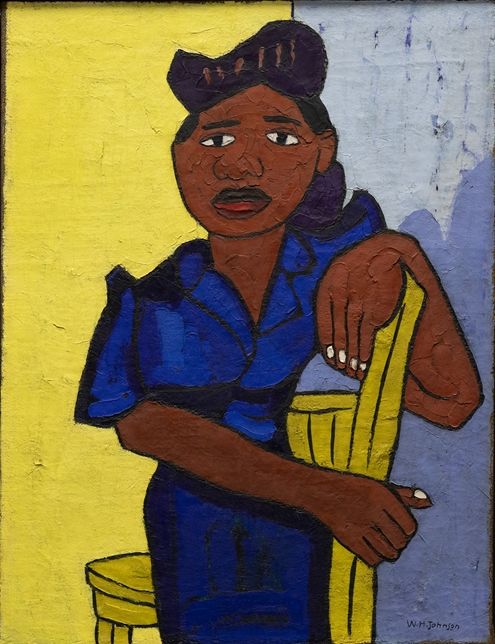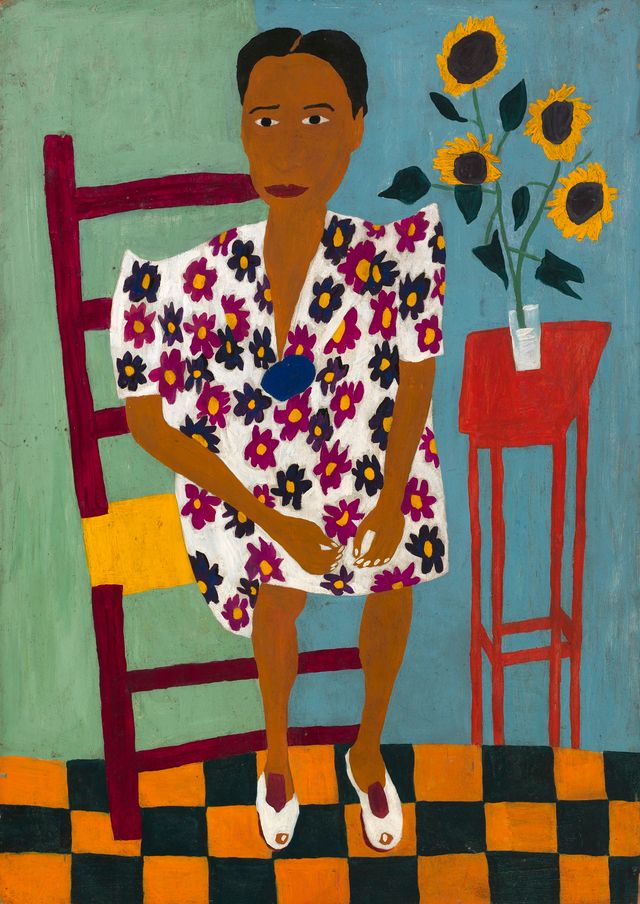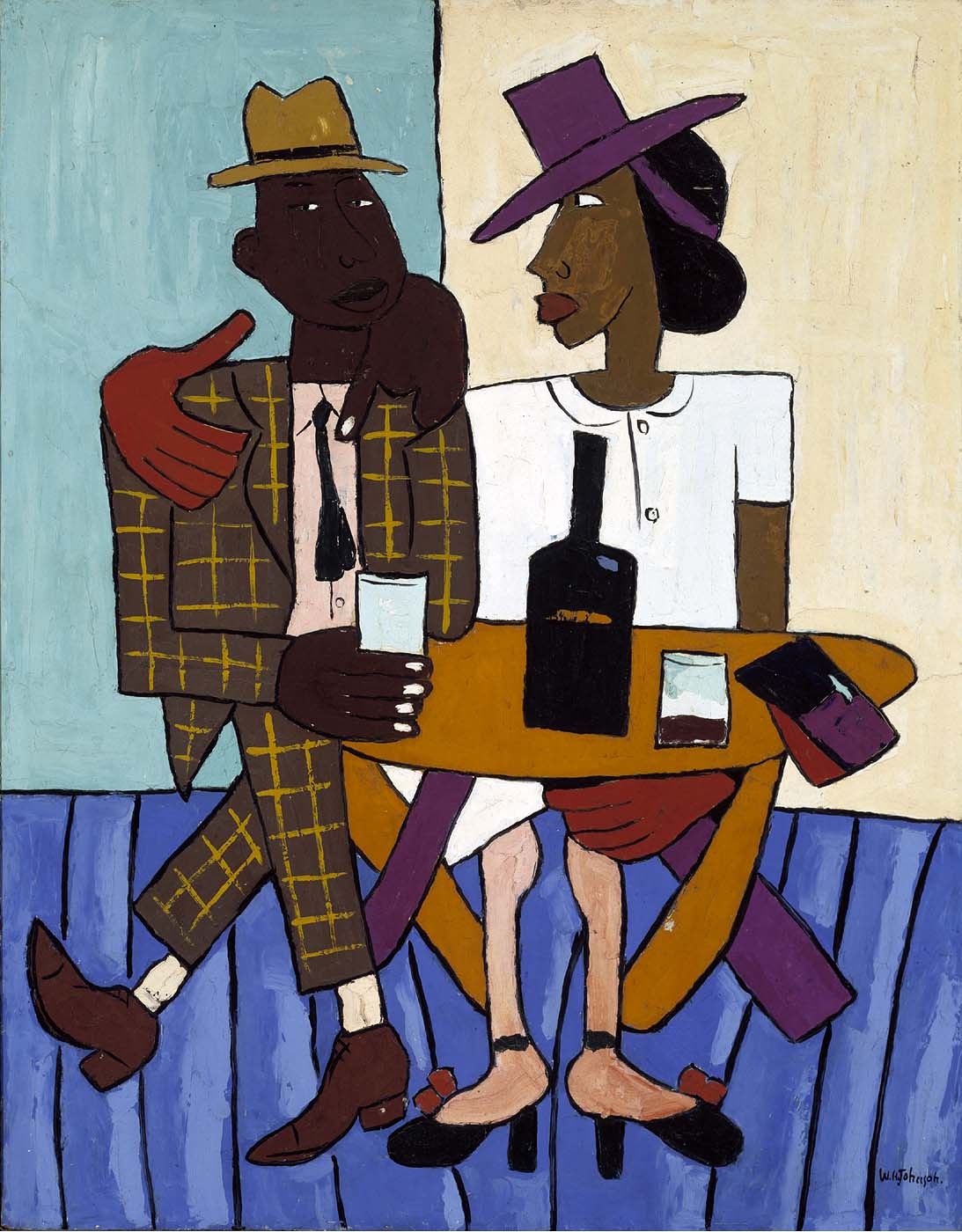William H. Johnson, Jitterbugs (I), ca. 1940-1941, gouache and pen and ink on paperboard, Smithsonian American Art Museum, Gift of the Harmon Foundation, 1967.59.1063

Jitterbugs (II)
William H. Johnson, ca. 1941, oil on paperboard. Smithsonian American Art Museum, Gift of the Harmon Foundation. 1967.59.611
By almost any standard, William H. Johnson (1901–1970) can be considered a major American artist. He produced hundreds of works in a virtuosic, eclectic career that spanned several decades as well as several continents. It was not until very recently, however, that his work began to receive the attention it deserves.

"And even if I have studied for many years and all over the world, . . . I have still been able to preserve the primitive in me. . . . My aim is to express in a natural way what I feel, what is in me, both rhythmically and spiritually, all that which in time has been saved up in my family of primitiveness and tradition, and which is now concentrated in me." — William H. Johnson quoted in Richard J. Powell, "In My Family of Primitiveness and Tradition: William H. Johnson's Jesus and the Three Marys, " American Art 5:4 (Fall 1991): 21.
William H. Johnson, Street Musicians, ca. 1939-1940, screenprint on paper, Smithsonian American Art Museum, Gift of Mrs. Douglas E. Younger, 1971.143

William H. Johnson, ca. 1941, oil on paperboard. Smithsonian American Art Museum, Gift of the Harmon Foundation. 1967.59.611
By almost any standard, William H. Johnson (1901–1970) can be considered a major American artist. He produced hundreds of works in a virtuosic, eclectic career that spanned several decades as well as several continents. It was not until very recently, however, that his work began to receive the attention it deserves.

William H. Johnson, Folk Family, ca. 1944, oil on plywood, Smithsonian American Art Museum, Gift of the Harmon Foundation, 1967.59.1055
"And even if I have studied for many years and all over the world, . . . I have still been able to preserve the primitive in me. . . . My aim is to express in a natural way what I feel, what is in me, both rhythmically and spiritually, all that which in time has been saved up in my family of primitiveness and tradition, and which is now concentrated in me." — William H. Johnson quoted in Richard J. Powell, "In My Family of Primitiveness and Tradition: William H. Johnson's Jesus and the Three Marys, " American Art 5:4 (Fall 1991): 21.
One of the most brilliant yet tragic careers of an early twentieth-century African-American artist was that of William H. Johnson. Originally from the Deep South, Johnson became a world traveler who absorbed the customs and cultures of New York, Europe, and North Africa. He completed hundreds of oils, watercolors, gouaches, pen-and-ink sketches, block prints, silk screens, and ceramics. Johnson's career also spanned a gamut of styles from the academic, through Impressionism, Cubism, Fauvism, and German Expressionism, to, finally, a "conscious naiveté".
Johnson was born on March 18, 1901,in Florence, South Carolina. The eldest of five children, he dropped out of school at an early age to help support his family. As a child he frequently copied cartoons from local newspapers, an activity that developed his ability to tell a story in witty pictures. Johnson left Florence around 1918 and moved to New York where he enrolled in the National Academy of Design and worked notably with the painter Charles Hawthorne. In 1926 Hawthorne raised funds to send Johnson abroad to study.
During the winter of 1926 Johnson traveled to France where he studied and painted in Paris, Moret-sur-Loing, and Cagnes-sur-Mer. From 1927 to 1929 he also visited Corsica, Nice, Belgium, and Denmark. Johnson's earliest works in Paris and Corsica were impressionistic landscapes and cityscapes. He quickly developed a short-hand technique that included only the essentials of design. In late 1929 Johnson returned to New York with a number of his French-Corsican paintings. He exhibited some of these works in the Harmon Foundation show of 1930 and received the coveted gold medal.
Following this success, Johnson returned to Europe and married a Danish textile artist, Holcha Krake, whom he had met in southern France. The newlywed Johnsons traveled across France and Belgium to Denmark where they settled in the small fishing village of Kerteminde, near his wife's home. The people of Kerteminde welcomed Johnson warmly and were fascinated by his paintings of gardens, old houses, and scenes of marine life.
In 1933 the Johnsons spent several months in North Africa where they delighted in the colorful Arabian bazaars and mosques, painted numerous portraits of the residents, worked in ceramics, and were taught age-old secrets of glazing and firing. The couple then traveled across Norway by bicycle. Johnson's paintings of that period capture the fresh atmosphere of spring with blossoming trees, the clear water of the deep fjords, and the blues of distant snow-capped mountains. Sailing next from Aalesund, Sweden, north to Tromsö, the two artists continued to paint and immerse themselves in the beauties of nature. They lived in Svolvær in the Lofoten Islands where Johnson painted and Holcha painted and wove her copy of the Baldishol Tapestry.
The threat of World War II prompted Johnson to return to the United States in 1938. In a pronounced and unexpected transition in his style, Johnson became interested in religious paintings and his subjects were almost exclusively African American. Using a palette of only four or five colors and painting frequently on burlap or plywood, Johnson developed a flat, consciously naive style. During the early 1940s, war activities, the Red Cross, and other related events interested Johnson and provided grist for his widely exhibited narrative paintings.
In January 1944 Johnson's wife Holcha died of cancer, an event that nearly shattered both his life and career. In June 1944 Johnson traveled to Florence, South Carolina, to visit his mother for the first time in fourteen years. There he painted a number of portraits of family and friends, as well as a series of paintings portraying seated women staring directly at the observer.
In 1945 Johnson began his final paintings—social, historical, andpolitical panels including a series of narrative themes built around single subjects such as Booker T. Washington and John Brown. These paintings were exhibited only once in the United States.
Late in 1946, still despondent over his wife's death, Johnson packed all of his art and returned to Denmark where he hoped to find peace among his wife's family in the country that he had grown to love. He exhibited his historical and political paintings in Copenhagen in March 1947, which was the last exhibition of his works held during his lifetime. There is quite a bit of Matisse's worship of unrestricted colors in his pictures," wrote a Danish critic of Johnson's last show, "But where Matisse is an aesthetician, Johnson goes further and shows us the working people of the southern states, the Negroes and their leaders, and their entirely strangely colorful world. . . ."
Late in 1946, still despondent over his wife's death, Johnson packed all of his art and returned to Denmark where he hoped to find peace among his wife's family in the country that he had grown to love. He exhibited his historical and political paintings in Copenhagen in March 1947, which was the last exhibition of his works held during his lifetime. There is quite a bit of Matisse's worship of unrestricted colors in his pictures," wrote a Danish critic of Johnson's last show, "But where Matisse is an aesthetician, Johnson goes further and shows us the working people of the southern states, the Negroes and their leaders, and their entirely strangely colorful world. . . ."
Johnson spent decades traveling the world, searching for the authentic spirit of ordinary people from different cultures. In the late 1930s, he found what he was looking for in his own African American community. The strong colors and silhouettes in this painting evoke the African art that black artists and writers had embraced during the Harlem Renaissance. But this affectionate couple also had the fashionable flash of zooit-suiters in the big band era. Above the table, the two figures coolly take in the café scene; below, a tangle of legs and limbs hints at the erotic energy of a night on the town.
Johnson, whose peculiar behavior had been noticed by close friends, became mentally ill shortly after his last show in Denmark. He was cared for temporarily in Denmark and later sent back to New York where he was hospitalized. On April 13, 1970, Johnson died at Central Islip State Hospital on Long Island, where he had spent the last twenty-three years of his life in obscurity, unable to produce any art. Today Johnson is considered one of the most important African-American artists of his generation.
William H. Johnson, Street Musicians, ca. 1939-1940, screenprint on paper, Smithsonian American Art Museum, Gift of Mrs. Douglas E. Younger, 1971.143

Sowing presents a simple narrative of farm life suggestive of Johnson’s upbringing in South Carolina, but the brilliant palette disguises elements of tension. The plow the man grips is stained with red streaks of iron-suffused earth. The woman’s hand is tightly clenched as she holds the seed above the soil before releasing it. A ghost moon in the sky hints at things both visible and unseen.

Image: William Henry Johnson (American, 1901–1970). Woman in Blue, c. 1943. Oil on burlap. Framed: 35 × 27 in. (88.9 × 68.6 cm). Clark Atlanta University Art Museum, Permanent Loan from the National Collection of Fine Art, 1969.013. Courtesy Clark Atlanta University Art Museum

William H. Johnson
Dateca. 1928-1930
Oil on canvas

William H. Johnson
Dateca. 1944
Oil on paperboard

William H. Johnson
Dateca. 1942
Oil on plywood

William H. Johnson
Dateca. 1940-1941
Oil on plywood



No comments:
Post a Comment